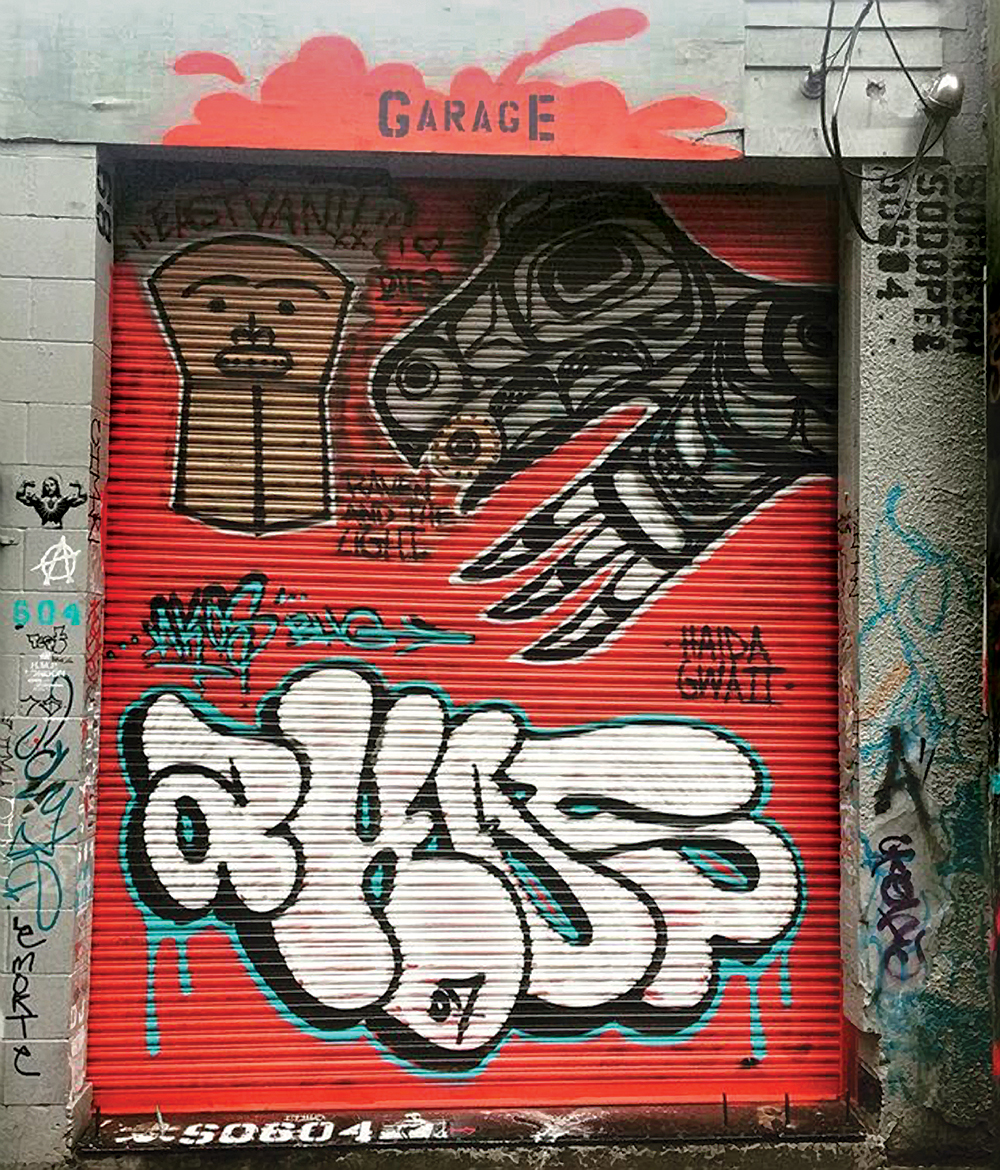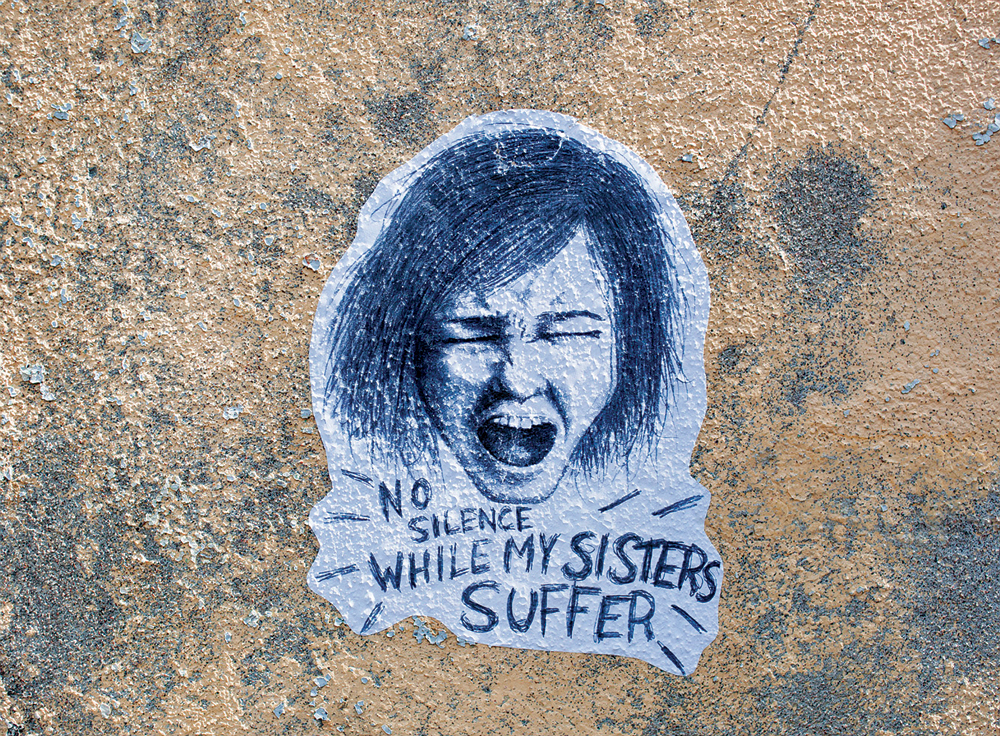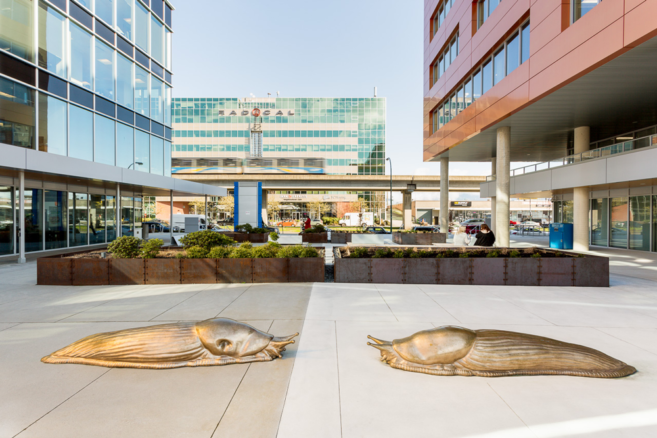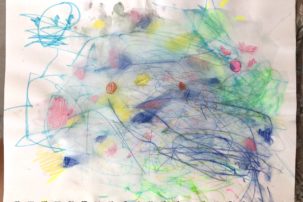Contemporary Indigenous art continues to gain institutional recognition in Canada. We can look to solo retrospectives of Indigenous artists, such as Alex Janvier at the National Gallery of Canada; Annie Pootoogook and Duane Linklater both winning the prestigious Sobey Art Award; and the appointment of Indigenous curators, arts administrators and artists into key institutional positions, such as Greg Hill at the National Gallery of Canada, or Wanda Nanibush at the Art Gallery of Ontario. But at the margins of contemporary Indigenous art writing and historicization, there are also alternative decolonial stories being shared—through unsanctioned Indigenous graffiti, murals, stencils, wheatpastes and other street-art interventions.
Indigenous street art sidesteps the Western institutions that determine formalized recognition of a professional artist: the education system, galleries, arts journalism, granting bodies. Sometimes anonymous, sometimes collectively signed, grassroots Indigenous street art rejects the restrictions of the institutional art world that can confine dialogue and expression to colonially designated spaces. With street interventions, there is no museum guide, media, administration or teacher to structure the viewer’s interpretation of the artwork. Indigenous street art facilitates a direct, uncensored propagation of anticolonial discourse to a wide public viewership.
Because of a resistance to institutional barriers and restrictions, street art creates space for the expression of marginalized voices. In a video for the Unceded Voices street-art project, the artist behind the moniker Red Bandit spoke of street art as empowering for Indigenous women and women of colour: “My father was a Sixties Scoop kid from the West Coast. Like my father, I grew up in the city without a Native parent to look up to. Without any kind of thread to lead me home. I’m a mixed baby. I belong nowhere. I am nobody, really. I am unwanted everywhere I go. I am a Native child in a world that seeks to erase me, but I will be heard.” For urban Indigenous youth, taking to the streets is an expression of liberation that allows them to bypass the struggle of integrating into the colonial art establishment.
 Street graffiti by Corey Bulpitt (Akos One) in Gastown, Vancouver, in March 2017. Photo: @vancouverscarpenter on Instagram.
Street graffiti by Corey Bulpitt (Akos One) in Gastown, Vancouver, in March 2017. Photo: @vancouverscarpenter on Instagram.
By foregrounding voices that are typically marginalized within the arts, street art intervenes in colonial space with alternative histories. Secwepemc curator Tania Willard explored the use of street art to mark Indigenous presence in public space in the touring exhibition “Beat Nation” (2008–14). In one of her curatorial statements, Willard wrote, “Branding the cityscape with spray-bombed Indigenous culture resonates with the idea of territory and reclaiming space in a city whose Indigenous roots are often hidden or disguised in a province of unceded Indigenous territories.” “Beat Nation” was such a success within gallery walls because it came from the streets: along the city’s alleys or highway underpasses, where you can stumble upon Haida formline murals and graffiti by Haida artist Corey Bulpitt (Akos One) and Ojibway artist Larissa Healey (Gurl Twenty Three).
Anticolonial street art reminds us that cities are also Indigenous territories, and that Indigeneity cannot be confined to stereotypical associations with natural environments, thereby disrupting the nature-culture divide. As Tagé Cho Hudän artist Lianne Charlie wrote in the Unceded Voices zine: “Our contributions to the wall, together, attempt to counter the erasure of Native people, place, and lifeways from parts of our homelands that are currently urban centres.” In Gwich’ya Gwich’in artist Nigit’stil Norbert’s Underground Resistance (2013), a series of wheatpastes marks urban spaces with flower designs based on her grandmother’s artworks. Norbert applies her wheatpastes in urban locales where natural elements—signs, she says, of “resilience in the cement urban environment”—can also be found. The intricate floral patterns stemming from Athabascan tradition are a form of resistance to daily confrontations with urban colonial systems. They embody the possibilities of resistance inherent in Indigenous storytelling.
Indigenous graffiti and murals function as a visual and public reinforcement of resilience in the face of settler colonialism. In Garden River First Nation, near Sault Ste. Marie, a train bridge is emblazoned with the anonymously painted words “This Is Indian Land”—an act of re-inscribing Indigenous visibility onto a colonized landscape. After This Is Indian Land became widely known, it inspired similar direct action onto colonized landscapes, such as Montreal’s No Olympics on Stolen Native Land mural by Zig Zag. No Olympics on Stolen Native Land is a strong denunciation of the social cleansing of street-involved communities by the city of Vancouver in preparation for the 2010 Olympics, and the games’ perpetuation of resource extraction in the surrounding territories. Anishinaabe artists Susan Blight and Hayden King have been likewise restoring an Indigenous presence to Toronto streets by replacing colonial street names with signs featuring Anishinaabemowin names. For this ongoing street intervention project, the artists remove the city’s signposts and furtively affix similar-looking signs that bear Anishinaabe place names and stories. In the first action of the series, in 2013, Queen Street was renamed Ogimaa Mikana—Ogimaa translating to leader and Mikana to path. The use of Anishinaabemowin to mark public space changes the context in which urban place names are understood, and thereby opens up the possibility for a decolonial understanding of place.
Decolonial street-art practices are a form of grassroots empowerment. Because street art operates outside of dominant art spaces, it defies the necessity of institutional recognition. Street art is an unmediated storytelling medium for marginalized voices to take control of their individual and collective selfhoods. It enables a thriving contemporary Indigenous urban culture that is accessible to all.
Camille Larivée is a community art organizer and street artist based in Montreal. She is the curator and lead organizer of Unceded Voices: Anticolonial Street Artists Convergence. Laurence Desmarais is a Montreal-based art historian and community organizer. She has a master’s degree from UQAM and has been working at the DIALOG Aboriginal Peoples Research and Knowledge Network for six years.
This post is adapted from an article from the Fall 2017 issue of Canadian Art.

 Red Bandit, No Silence While My Sisters Suffer, 2014. Paper, lead pencil and glue, 20.3 x 25.4 cm. Photo: Maxine Faure.
Red Bandit, No Silence While My Sisters Suffer, 2014. Paper, lead pencil and glue, 20.3 x 25.4 cm. Photo: Maxine Faure.







